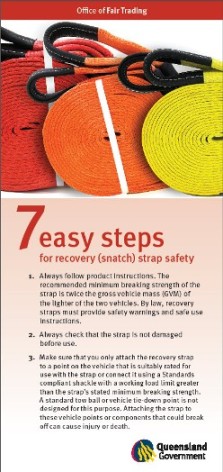Damaged or incorrectly used motor vehicle recovery straps can cause serious injury or death. Make sure you use the appropriate recovery strap for the job and that it meets the mandatory safety standard.
About motor vehicle recovery straps
Motor vehicle recovery straps, or snatch straps, are heavy duty straps designed to assist in pulling a vehicle when it is bogged.
The straps stretch and release energy under tension to achieve a sharp, jerking action, using the momentum of the towing vehicle to pull the bogged vehicle out.
Risks and injuries
The elasticity of the straps combined with the weight being towed are factors that mean serious injury or death may result if the straps are used incorrectly.
Vehicle damage, serious injuries and fatalities have resulted from vehicle strap failures.
Buying tips
- Make sure you select the correct strap relative to the vehicle's Gross Vehicle Mass (GVM). It is recommended that the minimum breaking strength of the strap is between 2 and 3 times the vehicle's GVM. The strap must be suited to the GVM of the lighter of the two vehicles used in the recovery process.
- Be aware that straps are not designed for recovery loads greater than 8 tonnes.
Safe use
- Check that the strap is not damaged or worn before use and be aware that the strap’s strength and stretch reduce when saturated.
- Only use the strap with proper robust recovery points. The force of the strap is likely to break or snap off normal attachment points such as tie-down eyes, tow balls, towbars, bull bars and suspension components.
- Drape a recovery damper, heavy bag or blanket over the strap during use to avoid rebound.
- Stay at a safe distance from both vehicles during the recovery process —at least 1.5 times the length of the un-stretched strap. Bystanders should never stand in the path of either vehicle
- Do not use the strap for lifting or conventional towing.



